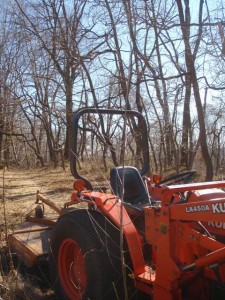Mariton: Sylvania
By Tim Burris, Mariton Preserve Manager
Sylvania means forest or woods. So, Penn’s Woods and Pennsylvania mean the same thing. What a ftting name. I often tell people that Pennsylvania wants to be forest. It only takes a little patience and the forest will return. Sometimes, you don’t need much patience.
There is a Wild Black Cherry (Prunus setonia) pictured by the tractor tire. It is a little hard to see, but it is taller than the roll bar (which is seven feet tall). One year ago, this field was mowed, so that young tree grew over seven feet in one growing season! There were lots of Cherries and Sassafras (Sassafras albidum) and even some Tuliptrees (Liriodendorn tulipifera) growing in this field before I mowed it this week.
Now, these young trees and shrubs had some help. I mow the meadows in March each year, when the roots are full of stored energy. As soon as the soil warmed, the tree roots reorganized and re-tooled to produce new shoots. That energy was concentrated in producing new trees, and they did a very good job.
From historical aerial photographs, we know that row crops grew in these fields in 1971. Probably shortly after that photograph, the fields went fallow. Soon after that, seeds from the trees along the edge entered the fallow fields and began growing. Since then, the roots have spread undergound sending up new shoots each spring after being mowed during the winter.
Here is a section (that was field) that I have not mowed since 2002. That makes this young forest ten years old. It is well established, in fact there is a Tuliptree in the foreground that is 5 inches in diameter. All I had to do was stop the annual mowing, and the forest came back.
Even in hostile environments, like the Serpentine Barrens, trees will begin growing if fire is suppressed for a few years. So, why do we at Natural Lands Trust spend so much time and money planting trees in fields, when they would come back naturally? My collegues at other preserves have more invasive plants and deer to deal with than I do. (I am a little farther north.) So, it is more effecient to establish a young forest with tree tubes (for the deer) and regular mowing between rows (for the invasives). But trust me, the forest would return without our help. After all, this is Pennsylvania.


